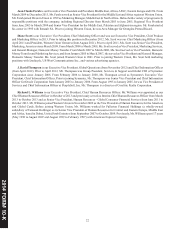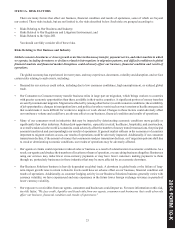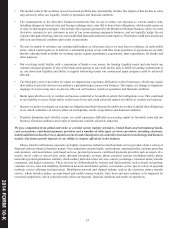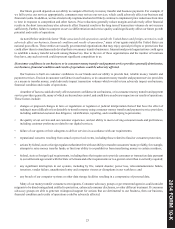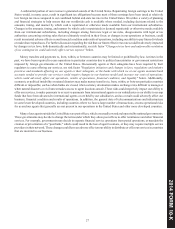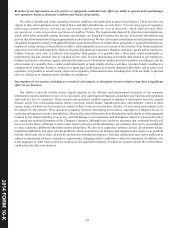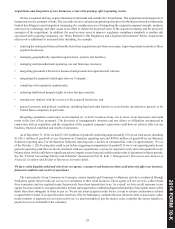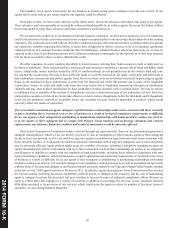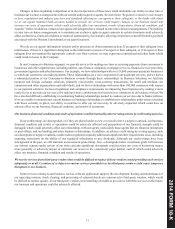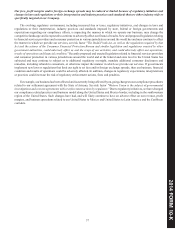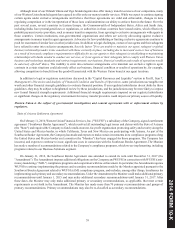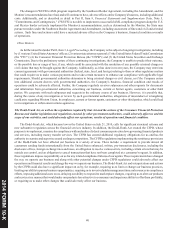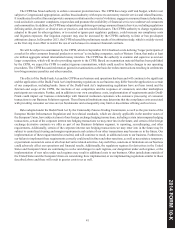Western Union 2014 Annual Report Download - page 170
Download and view the complete annual report
Please find page 170 of the 2014 Western Union annual report below. You can navigate through the pages in the report by either clicking on the pages listed below, or by using the keyword search tool below to find specific information within the annual report.
2014 FORM 10-K
32
We may not realize all of the anticipated benefits from productivity and cost-savings and other related initiatives, which may
include decisions to downsize or to transition operating activities from one location to another, and we may experience
disruptions in our workforce as a result of those initiatives.
We have engaged in actions and activities associated with productivity improvement initiatives and expense reduction
measures. We may implement additional initiatives in future periods. While these initiatives are designed to increase productivity
and result in cost savings, there can be no assurance that the anticipated benefits will be realized, and the costs to implement
such initiatives may be greater than expected. In addition, these initiatives have resulted and will likely result in the loss of
personnel, some of whom may support significant systems or operations. Consequently, these initiatives could result in a
disruption to our workforce. If we do not realize the anticipated benefits from these initiatives, or the costs to implement them
are greater than expected, or if the actions result in a disruption to our workforce greater than anticipated, our business, financial
condition, and results of operations could be adversely affected.
There can be no guarantee that we will continue to make dividend payments or repurchase stock.
For risks associated with our ability to continue to make dividend payments or repurchase shares, please see Part II, Item
5, Market for Registrant’s Common Equity, Related Stockholder Matters and Issuer Purchases of Equity Securities.
Our ability to remain competitive depends in part on our ability to protect our brands and our other intellectual property
rights and to defend ourselves against potential intellectual property infringement claims.
The Western Union brand, which is protected by trademark registrations in many countries, is material to our Company.
The loss of the Western Union trademark or a diminution in the perceived quality associated with the name would harm our
business. Similar to the Western Union trademark, the Vigo, Orlandi Valuta, Speedpay, Pago Fácil, Western Union Payments,
Quick Collect, Quick Pay, Convenience Pay, Western Union Business Solutions and other trademarks and service marks are
also important to our Company and a loss of the service mark or trademarks or a diminution in the perceived quality associated
with these names could harm our business.
Our intellectual property rights are an important element in the value of our business. Our failure to take appropriate actions
against those who infringe upon our intellectual property could adversely affect our business, financial condition and results of
operations.
The laws of certain foreign countries in which we do business do not protect intellectual property rights to the same extent
as do the laws of the United States. Adverse determinations in judicial or administrative proceedings in the United States or in
foreign countries could impair our ability to sell our services or license or protect our intellectual property, which could adversely
affect our business, financial condition and results of operations.
We have been, are and in the future may be, subject to claims alleging that our technology or business methods infringe
intellectual property rights of others, both inside and outside the United States. Unfavorable resolution of these claims could
require us to change how we deliver a service, result in significant financial consequences, or both, which could adversely affect
our business, financial condition and results of operations.
Changes in tax laws and unfavorable resolution of tax contingencies could adversely affect our tax expense.
Our future effective tax rates could be adversely affected by changes in tax laws, both domestically and internationally.
From time to time, the United States Congress and foreign, state and local governments consider legislation that could increase
our effective tax rates or impose other obligations. If changes to applicable tax laws are enacted, our results of operations could
be negatively impacted.


